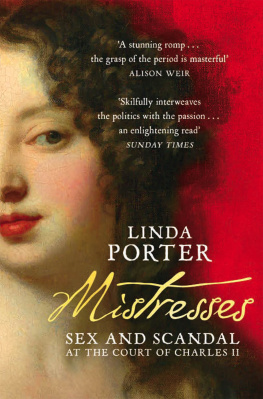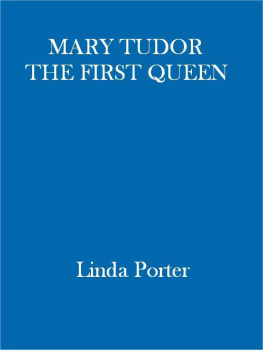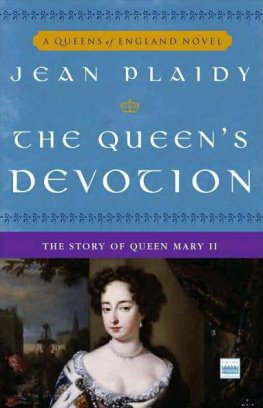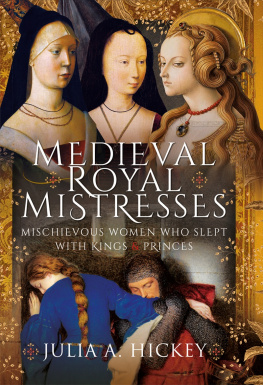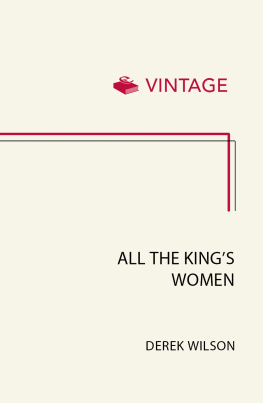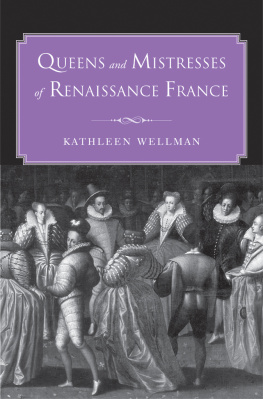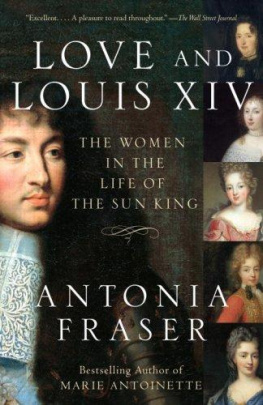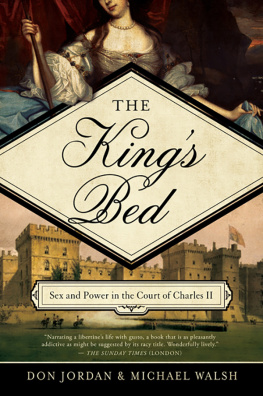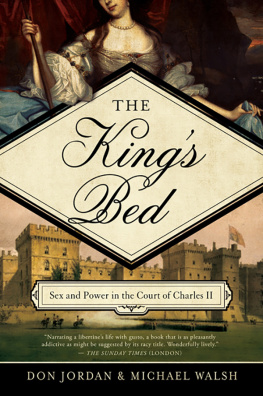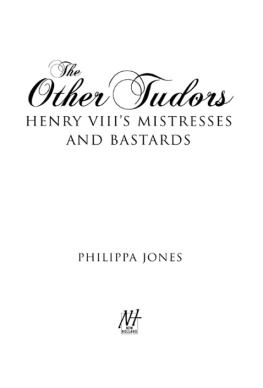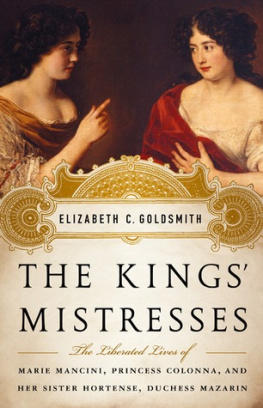Also by Linda Porter
Royal Renegades: The Children of Charles I and the English Civil Wars
Crown of Thistles: The Fatal Inheritance of Mary Queen of Scots
Katherine the Queen: The Remarkable Life of Katherine Parr
Mary Tudor: The First Queen
Authors Note
I T WAS ONLY when I began work on this book that I fully appreciated how extraordinarily complicated were the politics of the reign of Charles II. This might seem of secondary importance in a work about his mistresses, but the controversy which surrounded his lifestyle seeped into the heart of British life for the twenty-five years of his reign indeed, it had already begun to colour national and international reaction to him during the miserable years of his exile, during the latter years of the Civil Wars and throughout the period of the English republic that followed the execution of his father, Charles I. And, indeed, it matters far more that his mistresses were perceived as having influence at the time than whether they really did or not in hindsight. His tendency to shower money on them when he was frequently at loggerheads with Parliament over financial support and taxation made him reliant on other sources of income, notably from Louis XIV, the cousin who largely despised him. Though the king cheerfully took the money and fulfilled none of the promises he had secretly made in securing it (making him, at least on paper, a traitor to the country he ruled), this is scarcely an exoneration.
The mistresses themselves are a fascinating and flawed group of women. Only the actress Nell Gwyn is generally remembered today, but her predecessor Barbara Palmer, countess of Castlemaine, and Nells rival, Louise de Kroualle, duchess of Portsmouth, between them dominated the king in ways that Nell never could, the one through passion and the other through simpering guile. Frances Teresa Stuart, who arrived at the Restoration court from France in her mid-teens, hid a ruthless instinct for survival beneath a naive exterior and managed to stay out of the kings bed while having to submit to frequent public gropings that must have been excruciating. Hortense Mancini, duchess Mazarin, had led such a colourful life before taking refuge in England that some of the other ladies seem almost tame in comparison. While the kings mistresses aimed at celebrity and wealth, only his rejected wife, Catherine of Braganza, seems ever to have truly loved him. I have tried to give a more positive picture of this Portuguese princess than is often the case. Recent research on her cultural interests and approach to queenship has revealed that there was much more to Catherine than the weepy, despairing foreigner retreating into religion than is often supposed. Nor should we underestimate one of her less obvious achievements, that of making the drinking of tea for pleasure, as opposed to a strange medicinal brew, so fashionable.
Charles II ruled a deeply divided country, where religious persecution, whether of Catholics or Protestant non-conformists, was rife. His reign saw the beginnings of the two-party system which still, for good or ill, underpins British politics to this day. He cared nothing for Scotland or Ireland and was happy to trade on a false reputation for bonhomie, of being the sort of man that other men like because of his penchant for women and his apparent approachability, which was, in reality, a sham. The fact that he is still viewed as the Merrie Monarch and has been treated with indulgence by history (though not necessarily by historians) is something I find bewildering. Yet the contradictions remain. His private life makes Henry VIII look puritanical, but Charles II, despite the many and varied mistresses, could not be induced to divorce his wife, let alone execute her. His reign saw humiliation heaped on Britain from abroad and catastrophe overtake his capital in the mid-1660s, yet he somehow managed to survive and to dispense with Parliament in the closing years of his reign. The lasting impression of Charles II, when all the sordid glamour of his court and his mistresses is stripped away, is of a lazy, intelligent man, forever marked by the hardship of his formative years, a pleasure-loving cynic not quite redeemed by his death-bed conversion to Catholicism.
I should like to thank James Palmer at Dorney Court for letting me consult his archives on a very wet July day in 2017 and His Grace the Duke of Richmond and Gordon for permission to use the Goodwood Manuscript at the West Sussex Record Office. Dr Sean Cunningham and Elisabeth Novitski at the National Archives gave advice on sources and private archives. Crispin Powell, archivist to His Grace the Duke of Buccleuch, gave enthusiastic support to a request to look at the Montagu Papers at Boughton House in Northamptonshire. The staff at the London Library, British Library, Bodleian Library and West Sussex Record Office were unfailingly helpful. Thanks, as ever, to my editor, Georgina Morley, to Laura Carr, Managing Editor at Pan Macmillan and to Penelope Price, my copy-editor. With much gratitude also to my agent of many years, Andrew Lownie, and husband of even more years, George Porter, to whom one of my books is, at last, dedicated.
July 2019
Mistresses
Linda Porter has a doctorate in history from the University of York, where she studied early modern English and French history under the late Professor Gwyn Williams. She was the winner of the 2004 Biographers Club/Daily Mail Prize, which helped launch her on a new career as an author. She is the author of several works of historical biography, including Mary Tudor: The First Queen, Katherine the Queen, Crown of Thistles and Royal Renegades. She is a regular contributor to BBC History Magazine and History Today. She lives in Kent.
Select Bibliography
Manuscript Sources
B ODLEIAN L IBRARY
Clarendon State Papers, vol. 56
MS Carte, 3133, 47
B OUGHTON H OUSE , N ORTHAMPTONSHIRE
Montagu Papers
B RITISH L IBRARY
Additional MS 28044
Additional MS 2194721951
Additional MS 61486
Additional MS 88923
Harley MS 5277
D ORNEY C OURT A RCHIVES , B ERKSHIRE
Papers of the Palmer family, T15
S URREY H ISTORY C ENTRE
Brodrick (Midleton) Papers, MS 1248/1
T HE N ATIONAL A RCHIVES
Baschet Transcripts, PRO 31/3/105160
C 104/46
C 212/7/1
E 315/377
E156/20
PRO 30/50/32
PROB 1/56
PROB 11/363/469
PROB 11/466/369
PROB 32/53/38SP 78/115148
SP 84/165/133
SP 89/15/25
W EST S USSEX R ECORD O FFICE
Goodwood MSS, 15, 7, 103, 391, 1071, 1427, 1889, 1990, 1903, 1965, 2245
Primary Sources
(Place of publication for all printed works is London, unless otherwise stated)
A Collection of the State Papers of John Thurloe, Esq., T. Birch (ed.), 7 vols, 1742
Andrew Marvell, The Complete Poems, G. de F. Lord (ed.), 1984
An Historical Account of the Heroick Life and Magnanimous Actions of the Most Illustrious Protestant Prince, James, Duke of Monmouth, 1683
Annals of the Reign of Queen Anne, Abel Boyer (ed.), 1722
Buckingham, Public and Private Man, C. Phipps (ed.), 1985
Burnet, Gilbert, History of His Own Time, 1753
Calendar of State Papers Domestic, Charles II, M. A. E. Green (ed.), 28 vols, 1860
Calendar of State Papers Domestic, Interregnum

